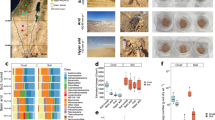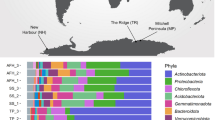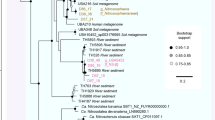Abstract
Carbonate caves represent subterranean ecosystems that are largely devoid of phototrophic primary production. In semiarid and arid regions, allochthonous organic carbon inputs entering caves with vadose-zone drip water are minimal, creating highly oligotrophic conditions; however, past research indicates that carbonate speleothem surfaces in these caves support diverse, predominantly heterotrophic prokaryotic communities. The current study applied a metagenomic approach to elucidate the community structure and potential energy dynamics of microbial communities, colonizing speleothem surfaces in Kartchner Caverns, a carbonate cave in semiarid, southeastern Arizona, USA. Manual inspection of a speleothem metagenome revealed a community genetically adapted to low-nutrient conditions with indications that a nitrogen-based primary production strategy is probable, including contributions from both Archaea and Bacteria. Genes for all six known CO2-fixation pathways were detected in the metagenome and RuBisCo genes representative of the Calvin–Benson–Bassham cycle were over-represented in Kartchner speleothem metagenomes relative to bulk soil, rhizosphere soil and deep-ocean communities. Intriguingly, quantitative PCR found Archaea to be significantly more abundant in the cave communities than in soils above the cave. MEtaGenome ANalyzer (MEGAN) analysis of speleothem metagenome sequence reads found Thaumarchaeota to be the third most abundant phylum in the community, and identified taxonomic associations to this phylum for indicator genes representative of multiple CO2-fixation pathways. The results revealed that this oligotrophic subterranean environment supports a unique chemoautotrophic microbial community with potentially novel nutrient cycling strategies. These strategies may provide key insights into other ecosystems dominated by oligotrophy, including aphotic subsurface soils or aquifers and photic systems such as arid deserts.
Similar content being viewed by others
Log in or create a free account to read this content
Gain free access to this article, as well as selected content from this journal and more on nature.com
or
References
Banks ED, Taylor NM, Gulley J, Lubbers BR, Giarrizo JG, Bullen HA et al (2010). Bacterial calcium carbonate precipitation in cave environments: a function of calcium homeostasis. Geomicrobiol J 27: 444–454.
Barton HA, Northup DE . (2007). Geomicrobiology in cave environments: past, current and future perspectives. J Cave Karst Stud 69: 163–178.
Barton HA, Taylor MR, Pace NR . (2004). Molecular phylogenetic analysis of a bacterial community in an oligotrophic cave environment. Geomicrobiol J 21: 11–20.
Barton HA, Taylor NM, Kreate MP, Springer AC, Oehrle SA, Bertog JL . (2007). The impact of host rock geochemistry on bacterial community structure in oligotrophic cave environments. Int J Speleol 36: 93–104.
Bartosch S, Hartwig C, Spieck E, Bock E . (2002). Immunological detection of Nitrospira-like bacteria in various soils. Microb Ecol 43: 26–33.
Bates ST, Berg-Lyons D, Caporaso JG, Walters WA, Knight R, Fierer N . (2011). Examining the global distribution of dominant archaeal populations in soil. ISME J 5: 908–917.
Berg IA . (2011). Ecological aspects of the distribution of different autotrophic CO2 fixation pathways. Appl Environ Microbiol 77: 1925–1936.
Berg IA, Kockelkorn D, Buckel W, Fuchs G . (2007). A 3-hydroxypropionate/4-hydroxybutyrate autotrophic carbon dioxide assimilation pathway in archaea. Science 318: 1782–1786.
Berg IA, Kockelkorn D, Ramos-Vera WH, Say RF, Zarzycki J, Hugler M et al (2010). Autotrophic carbon fixation in archaea. Nat Rev Microbiol 8: 447–460.
Borneman J, Hartin RJ . (2000). PCR primers that amplify fungal rRNA genes from environmental samples. Appl Environ Microbiol 66: 4356–4360.
Cantoni O, Sestili P, Cattabeni F, Bellomo G, Pou S, Cohen M et al (1989). Calcium chelator quin 2 prevents hydrogen-peroxide-induced DNA breakage and cytotoxicity. Eur J Biochem 182: 209–212.
Castro HF, Classen AT, Austin EE, Norby RJ, Schadt CW . (2010). Soil microbial community responses to multiple experimental climate change drivers. Appl Environ Microbiol 76: 999–1007.
Chelius M, Moore J . (2004). Molecular phylogenetic analysis of archaea and bacteria in Wind Cave, South Dakota. Geomicrobiol J 21: 123–134.
Chen Y, Wu L, Boden R, Hillebrand A, Kumaresan D, Moussard H et al (2009). Life without light: microbial diversity and evidence of sulfur- and ammonium-based chemolithotrophy in Movile Cave. ISME J 3: 1093–1104.
Contos AK, James JM, Heywood K, Pitt K, Rogers P . (2001). Morphoanalysis of bacterially precipitated subaqueous calcium carbonate from Weebubbie Cave, Australia. Geomicrobiol J 18: 331–343.
Delmont TO, Malandain C, Prestat E, Larose C, Monier JM, Simonet P et al (2011). Metagenomic mining for microbiologists. ISME J 5: 1837–1843.
Drees KP, Neilson JW, Betancourt JL, Quade J, Henderson DA, Pryor BM et al (2006). Bacterial community structure in the hyperarid core of the Atacama Desert, Chile. Appl Environ Microbiol 72: 7902–7908.
Einen J, Thorseth IH, Ovreas L . (2008). Enumeration of archaea and bacteria in seafloor basalt using real-time quantitative PCR and fluorescence microscopy. FEMS Microbiol Lett 282: 182–187.
Engel AS, Meisinger DB, Porter ML, Payn RA, Schmid M, Stern LA et al (2010). Linking phylogenetic and functional diversity to nutrient spiraling in microbial mates from Lower Kane Cave (USA). ISME J 4: 98–110.
Gerhardt A, Cinkaya I, Linder D, Huisman G, Buckel W . (2000). Fermentation of 4-aminobutyrate by clostridium aminobutyricum: Cloning of two genes involved in the formation and dehydration of 4-hydroxybutyryl-CoA. Arch Microbiol 174: 189–199.
Gomez-Alvarez V, Teal TK, Schmidt TM . (2009). Systematic artifacts in metagenomes from complex microbial communities. ISME J 3: 1314–1317.
Gonzalez JM, Portillo MC, Saiz-Jimenez C . (2006). Metabolically active Crenarchaeota in Altamira Cave. Naturwissenschaften 93: 42–45.
Hallam SJ, Konstantinidis KT, Putnam N, Schleper C, Watanabe Y, Sugahara J et al (2006). Genomic analysis of the uncultivated marine crenarchaeote Cenarchaeum symbiosum. Proc Natl Acad Sci USA 103: 18296–18301.
Hatzenpichler R, Lebedeva EV, Spieck E, Stoecker K, Richter A, Daims H et al (2008). A moderately thermophilic ammonia-oxidizing crenarchaeote from a hot spring. Proc Natl Acad Sci USA 105: 2134–2139.
Holmes AJ, Tujula NA, Holley M, Contos A, James JM, Rogers P et al (2001). Phylogenetic structure of unusual aquatic microbial formations in Nullarbor Caves, Australia. Environ Microbiol 3: 256–264.
Huber H, Gallenberger M, Jahn U, Eylert E, Berg IA, Kockelkorn D et al (2008). A dicarboxylate/4-hydroxybutyrate autotrophic carbon assimilation cycle in the hyperthermophilic archaeum Ignicoccus hospitalis. Proc Natl Acad Sci USA 105: 7851–7856.
Hurwitz BL, Deng L, Poulos BT, Sullivan MB . (2012). Evaluation of methods to concentrate and purify ocean virus communities through comparative, replicated metagenomics. Environ Microbiol 15: 1428–1440.
Huse SM, Huber JA, Morrison HG, Sogin ML, Welch DM . (2007). Accuracy and quality of massively parallel DNA pyrosequencing. Genome Biol 8: R143.
Huson DH, Auch AF, Qi J, Schuster SC . (2007). MEGAN analysis of metagenomic data. Genome Res 17: 377–386.
Ikner LA, Toomey RS, Nolan G, Neilson JW, Pryor BM, Maier RM . (2007). Culturable microbial diversity and the impact of tourism in Kartchner Caverns, Arizona. Microb Ecol 53: 30–42.
Jagnow DH . (1999). Geology of Kartchner Caverns State Park, Arizona. J Cave Karst Stud 61: 49–58.
Jones DS, Albrecht HL, Dawson KS, Schaperdoth I, Freeman KH, Pi Y et al (2012). Community genomic analysis of an extremely acidophilic sulfur-oxidizing biofilm. ISME J 6: 158–170.
Kim BK, Jung MY, Yu DS, Park SJ, Oh TK, Rhee SK et al (2011). Genome sequence of an ammonia-oxidizing soil archaeon, "Candidatus Nitrosoarchaeum koreensis" My1. J Bacteriol 193: 5539–5540.
Konneke M, Bernhard AE, de la Torre JR, Walker CB, Waterbury JB, Stahl DA . (2005). Isolation of an autotrophic ammonia-oxidizing marine archaeon. Nature 437: 543–546.
Kraft B, Strous M, Tegetmeyer HE . (2011). Microbial nitrate respiration—genes, enzymes and environmental distribution. J Biotechnol 155: 104–117.
Laiz L, Groth I, Gonzalez I, Saiz-Jimenez C . (1999). Microbiological study of the dripping waters in Altamira Cave (Santillana del Mar, Spain). J Microbiol Meth 36: 129–138.
Lauro FM, McDougald D, Thomas T, Williams TJ, Egan S, Rice S et al (2009). The genomic basis of trophic strategy in marine bacteria. Proc Natl Acad Sci USA 106: 15527–15533.
Legatzki A, Ortiz M, Neilson JW, Casavant RR, Palmer MW, Rasmussen C et al (2012). Factors influencing observed variations in the structure of bacterial communities on calcite formations in Kartchner Caverns, AZ, USA. Geomicrobiol J 29: 422–434.
Legatzki A, Ortiz M, Neilson JW, Dominguez S, Andersen GL, Toomey RS et al (2011). Bacterial and archaeal community structure of two adjacent calcite speleothems in Kartchner Caverns, Arizona, USA. Geomicrobiol J 28: 99–117.
Lucker S, Wagner M, Maixner F, Pelletier E, Koch H, Vacherie B et al (2010). A Nitrospira metagenome illuminates the physiology and evolution of globally important nitrite-oxidizing bacteria. Proc Natl Acad Sci USA 107: 13479–13484.
Macalady JL, Jones DS, Lyon EH . (2007). Extremely acidic, pendulous cave wall biofilms from the Frasassi Cave system, Italy. Environ Microbiol 9: 1402–1414.
Markert S, Arndt C, Felbeck H, Becher D, Sievert SM, Hugler M et al (2007). Physiological proteomics of the uncultured endosymbiont of Riftia pachyptila. Science 315: 247–250.
Markowitz VM, Mavromatis K, Ivanova NN, Chen IM, Chu K, Kyrpides NC . (2009). IMG ER: A system for microbial genome annotation expert review and curation. Bioinformatics 25: 2271–2278.
Martens-Habbena W, Berube PM, Urakawa H, de la Torre JR, Stahl DA . (2009). Ammonia oxidation kinetics determine niche separation of nitrifying archaea and bacteria. Nature 461: 976–979.
Nakagawa S, Takai K . (2008). Deep-sea vent chemoautotrophs: diversity, biochemistry and ecological significance. FEMS Microbiol Ecol 65: 1–14.
Norris PR, Davis-Belmar CS, Brown CF, Calvo-Bado LA . (2011). Autotrophic, sulfur-oxidizing actinobacteria in acidic environments. Extremophiles 15: 155–163.
Northup DE, Barns SM, Yu LE, Spilde MN, Schelble RT, Dano KE et al (2003). Diverse microbial communities inhabiting ferromanganese deposits in Lechuguilla and Spider Caves. Environ Microbiol 5: 1071–1086.
Ortiz M, Neilson JW, Nelson WM, Legatzki A, Byrne A, Yu Y et al (2013). Profiling bacterial diversity and taxonomic composition on speleothem surfaces in Kartchner Caverns, AZ. Microb Ecol 65: 371–383.
Pester M, Schleper C, Wagner M . (2011). The Thaumarchaeota: An emerging view of their phylogeny and ecophysiology. Curr Opin Microbiol 14: 300–306.
Porca E, Jurado V, Zgur-Bertok D, Saiz-Jimenez C, Pasic L . (2012). Comparative analysis of yellow microbial communities growing on the walls of geographically distinct caves indicates a common core of microorganisms involved in their formation. FEMS Microbiol Ecol 81: 255–266.
Portillo MC, Gonzalez JM, Saiz-Jimenez C . (2008). Metabolically active microbial communities of yellow and grey colonizations on the walls of Altamira Cave, Spain. J Appl Microbiol 104: 681–691.
Pratscher J, Dumont MG, Conrad R . (2011). Ammonia oxidation coupled to CO2 fixation by archaea and bacteria in an agricultural soil. Proc Natl Acad Sci USA 108: 4170–4175.
Ramos-Vera WH, Berg IA, Fuchs G . (2009). Autotrophic carbon dioxide assimilation in Thermoproteales revisited. J Bacteriol 191: 4286–4297.
Rütting T, Boeckx P, Müller C, Klemedtsson L . (2011). Assessment of the importance of dissimilatory nitrate reduction to ammonium for the terrestrial nitrogen cycle. Biogeosciences 8: 1779–1791.
Sarbu SM, Kane TC, Kinkle BK . (1996). A chemoautotrophically based cave ecosystem. Science 272: 1953–1955.
Simon KS, Benfield EF, Macko SA . (2003). Food web structure and the role of epilithic biofilms in cave streams. Ecology 84: 2395–2406.
Solis-Dominguez FA, Valentin-Vargas A, Chorover J, Maier RM . (2011). Effect of arbuscular mycorrhizal fungi on plant biomass and the rhizosphere microbial community structure of mesquite grown in acidic lead/zinc mine tailings. Sci Total Environ 409: 1009–1016.
Spear JR, Barton HA, Robertson CE, Francis CA, Pace NR . (2007). Microbial community biofabrics in a geothermal mine adit. Appl Environ Microbiol 73: 6172–6180.
Strauss G, Eisenreich W, Bacher A, Fuchs G . (1992). 13c-nmr study of autotrophic CO2 fixation pathways in the sulfur-reducing archaebacterium Thermoproteus neutrophilus and in the phototrophic eubacterium Chloroflexus aurantiacus. Eur J Biochem 205: 853–866.
Tetu SG, Breakwell K, Elbourne LD, Holmes AJ, Gillings MR, Paulsen IT . (2013). Life in the dark: Metagenomic evidence that a microbial slime community is driven by inorganic nitrogen metabolism. ISME J 7: 1227–1236.
Toomey RS, Nolan G (2005). Environmental change at Kartchner Caverns: Trying to separate natural and anthropogenic changes. In: Gottfried GJ, Gebow BS, Eskew LG, Edminster CB (eds.) Connecting mountain islands and desert seas: Biodiveristy and management of the Madrean ArchipelagoII. Proceedings RMRS-P-36, US Department of Agriculture, Forest Service, Rocky Mountain Research Station: Fort Collins, CO. pp 264–270.
Tufts R, Tenen G . (1999). Discovery and history of Kartchner Caverns, Arizona. J Cave Karst Stud 61: 44–48.
Utaker JB, Andersen K, Aakra A, Moen B, Nes IF . (2002). Phylogeny and functional expression of ribulose 1,5-bisphosphate carboxylase/oxygenase from the autotrophic ammonia-oxidizing bacterium Nitrosospira sp. Isolate 40ki. J Bacteriol 184: 468–478.
Wang Y, Cheng H, Edwards RL, He Y, Kong X, An Z et al (2005). The holocene asian monsoon: Links to solar changes and north atlantic climate. Science 308: 854–857.
Zhang LM, Offre PR, He JZ, Verhamme DT, Nicol GW, Prosser JI . (2010). Autotrophic ammonia oxidation by soil thaumarchaea. Proc Natl Acad Sci USA 107: 17240–17245.
Zhou J, Gu Y, Zou C, Mo M . (2007). Phylogenetic diversity of bacteria in an earth-cave in Guizhou Province, Southwest of China. J Microbiol 45: 105–112.
Acknowledgements
We express our appreciation to Robert Casavant, Ginger Nolan and Steve Willsey of Arizona State Parks for their assistance in Kartchner Caverns and Nick Sisneros, and Yeisoo Yu of the Arizona Genomics Institute for extensive assistance with pyrosequencing. Funding for this work was provided by the National Science Foundation Microbial Observatory grant MCB0604300 and a University of Arizona National Science Foundation IGERT Genomics Initiative fellowship awarded to Marianyoly Ortiz, grant no. DGE-0654423. This work represents an original research paper.
Author information
Authors and Affiliations
Corresponding author
Ethics declarations
Competing interests
The authors declare no conflict of interest.
Additional information
Supplementary Information accompanies this paper on The ISME Journal website
Supplementary information
Rights and permissions
About this article
Cite this article
Ortiz, M., Legatzki, A., Neilson, J. et al. Making a living while starving in the dark: metagenomic insights into the energy dynamics of a carbonate cave. ISME J 8, 478–491 (2014). https://doi.org/10.1038/ismej.2013.159
Received:
Revised:
Accepted:
Published:
Issue date:
DOI: https://doi.org/10.1038/ismej.2013.159
Keywords
This article is cited by
-
Metagenome Analysis of Speleothem Microbiome from Subterranean Cave Reveals Insight into Community Structure, Metabolic Potential, and BGCs Diversity
Current Microbiology (2023)
-
The diversity of microbes and prediction of their functions in karst caves under the influence of human tourism activities—a case study of Zhijin Cave in Southwest China
Environmental Science and Pollution Research (2022)
-
The role of bacterial community in the formation of a stalactite in coral limestone areas of Taiwan by 16S rRNA gene amplicon surveys
Environmental Earth Sciences (2021)
-
Diversity of Polyketide Synthases and Nonribosomal Peptide Synthetases Revealed Through Metagenomic Analysis of a Deep Oligotrophic Cave
Microbial Ecology (2021)
-
Co-occurrence pattern and function prediction of bacterial community in Karst cave
BMC Microbiology (2020)



